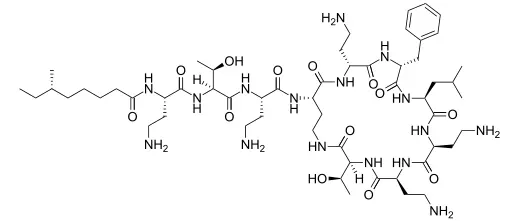In the face of the escalating threat of antibiotic resistance, a growing arsenal of once-effective antibiotics is becoming increasingly ineffective. This has led to a critical need for alternative treatment options for infections caused by multidrug-resistant Gram-negative bacteria, such as Pseudomonas aeruginosa, Acinetobacter baumannii, and Klebsiella pneumoniae. Enter Polymyxin B, a cyclic peptide antibiotic that has emerged as a last-line therapeutic option against these formidable pathogens.
Polymyxin B: Mechanism of Action
Polymyxin B exerts its antimicrobial activity by targeting the integrity of the bacterial cell membrane. It interacts with lipopolysaccharides (LPS), major components of the outer membrane of Gram-negative bacteria. This interaction disrupts the structural integrity of the membrane, leading to cell lysis and ultimately, bacterial death. This unique mechanism of action distinguishes Polymyxin B from many other antibiotics that target intracellular processes.

Clinical Applications and Limitations
Given its potent activity against multidrug-resistant Gram-negative bacteria, Polymyxin B plays a crucial role in the treatment of severe infections, including bacteremia, pneumonia, and urinary tract infections. However, its clinical use is often limited due to potential for significant side effects, primarily nephrotoxicity (kidney damage) and neurotoxicity. These adverse effects necessitate careful patient monitoring and often limit the duration of treatment.
Research and Development Efforts
To address the limitations of Polymyxin B, researchers are actively exploring strategies to improve its therapeutic profile. These efforts include:
- Developing Polymyxin B derivatives: Chemical modifications of the Polymyxin B structure aim to reduce its toxicity while maintaining its potent antibacterial activity.
- Investigating novel delivery methods: Exploring alternative delivery routes, such as liposomal formulations or targeted delivery systems, to minimize systemic exposure and reduce the risk of side effects.
- Combination therapies: Combining Polymyxin B with other antibiotics or adjunctive therapies to enhance its efficacy and potentially reduce the risk of adverse events.
The Future of Polymyxin B
Despite its limitations, Polymyxin B remains an invaluable tool in the fight against multidrug-resistant infections. Continued research and development efforts are crucial to optimize its therapeutic potential and ensure its continued availability as a last-line defense against these formidable pathogens.
Keywords: Polymyxin B, antibiotic resistance, multidrug-resistant bacteria, Gram-negative bacteria, Pseudomonas aeruginosa, Acinetobacter baumannii, Klebsiella pneumoniae, lipopolysaccharides, nephrotoxicity, neurotoxicity, drug development, antimicrobial peptides, cyclic peptides, bacteremia, pneumonia, urinary tract infections, drug delivery, combination therapy, therapeutic window, last-line antibiotics